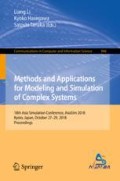Abstract
Recently, automated material handling systems (AMHSs) in semiconductor fabrication plants (FABs) in South Korea have become a new and major bottleneck. This is mainly because the number of long-distance transportation requests has increased as the FAB area has widened. This paper presents a deep-learning-based adaptive method for the storage-allocation problem to improve the AMHS throughput capacity.
The AMHS in this research consists of overhead hoist transfer transports (OHTs), a unified rail for the OHTs, etc. The main problem involves scheduling (or designating) an intermediate buffer, e.g., a stocker or a side track buffer, for a single lot. Thus far, a static optimization approach has been widely applied to the problem. This research shows that a learning-based adaptive storage-allocation strategy can increase the AMHS capacity in terms of throughput. The deep-learning model considers various production conditions, including processing time, transportation time, and the distribution of works in process (WIP).
This research was supported by Basic Science Research Program through the National Research Foundation of Korea (NRF) funded by the Ministry of Education (NRF-2017R1D1A3B03028784).
Access this chapter
Tax calculation will be finalised at checkout
Purchases are for personal use only
References
Abdelmaguid, T.F., Nassef, A.O., Kamal, B.A., Hassan, M.F.: A hybrid GA/heuristic approach to the simultaneous scheduling of machines and automated guided vehicles. Int. J. Prod. Res. 42(2), 267–281 (2004)
El-Bouri, A., Shah, P.: A neural network for dispatching rule selection in a job shop. Int. J. Adv. Manuf. Technol. 31(3–4), 342–349 (2006)
Heger, J., Bani, H., Scholz-Reiter, B.: Improving production scheduling with machine learning. In: 3rd Workshop on Artificial Intelligence and Logistics, pp. 43–48 (2012)
Heger, J., Branke, J., Hildebrandt, T., Scholz-Reiter, B.: Dynamic adjustment of dispatching rule parameters in flow shops with sequence-dependent set-up times. Int. J. Prod. Res. 54(22), 6812–6824 (2016)
Kianfar, K., Ghomi, S.F., Jadid, A.O.: Study of stochastic sequence-dependent flexible flow shop via developing a dispatching rule and a hybrid GA. Eng. Appl. Artif. Intell. 25(3), 494–506 (2012)
Korytkowski, P., Wiśniewski, T., Rymaszewski, S.: An evolutionary simulation-based optimization approach for dispatching scheduling. Simul. Model. Pract. Theory 35, 69–85 (2013)
Liu, H., Dong, J.J.: Dispatching rule selection using artificial neural networks for dynamic planning and scheduling. J. Intell. Manuf. 7(3), 243–250 (1996)
Mönch, L., Fowler, J.W., Mason, S.J.: Production Planning and Control for Semiconductor Wafer Fabrication Facilities. Springer, New York (2013). https://doi.org/10.1007/978-1-4614-4472-5
Scholz-Reiter, B., Heger, J., Hildebrandt, T.: Gaussian processes for dispatching rule selection in production scheduling: comparison of learning techniques. In: 2010 IEEE International Conference on Data Mining Workshops (ICDMW), pp. 631–638 (2010)
Siebert, M., et al.: Lot targeting and lot dispatching decision policies for semiconductor manufacturing: optimisation under uncertainty with simulation validation. Int. J. Prod. Res. 56(1–2), 629–641 (2018)
Tamani, K., Boukezzoula, R., Habchi, G.: Application of a continuous supervisory fuzzy control on a discrete scheduling of manufacturing systems. Eng. Appl. Artif. Intell. 24(7), 1162–1173 (2011)
Wakabayashi, T., Watanabe, S., Kobayashi, Y., Okabe, T., Koike, A.: High-speed AMHS and its operation method for 300-mm QTAT FAB. IEEE Trans. Semicond. Manuf. 17(3), 317–323 (2004)
Author information
Authors and Affiliations
Corresponding author
Editor information
Editors and Affiliations
Rights and permissions
Copyright information
© 2018 Springer Nature Singapore Pte Ltd.
About this paper
Cite this paper
Kim, H., Lim, DE. (2018). Deep-Learning-Based Storage-Allocation Approach to Improve the AMHS Throughput Capacity in a Semiconductor Fabrication Facility. In: Li, L., Hasegawa, K., Tanaka, S. (eds) Methods and Applications for Modeling and Simulation of Complex Systems. AsiaSim 2018. Communications in Computer and Information Science, vol 946. Springer, Singapore. https://doi.org/10.1007/978-981-13-2853-4_18
Download citation
DOI: https://doi.org/10.1007/978-981-13-2853-4_18
Published:
Publisher Name: Springer, Singapore
Print ISBN: 978-981-13-2852-7
Online ISBN: 978-981-13-2853-4
eBook Packages: Computer ScienceComputer Science (R0)

